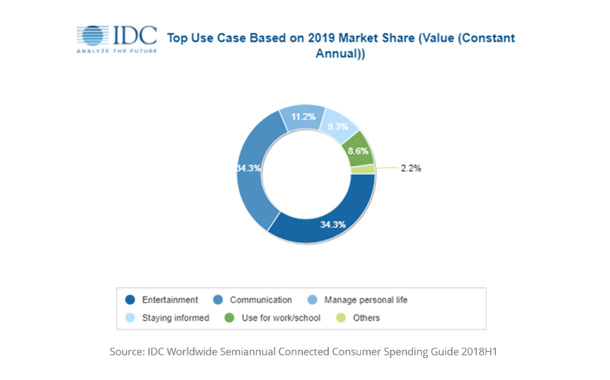Asia/Pacific consumer spending on technology will reach $468.8 billion in 2019, an increase of 4.2% from the year, according to the inaugural release of the IDC Worldwide Semi-annual Connected Consumer Spending Guide. Consumer purchases of traditional and emerging technologies will showcase its rise over the forecast period (2018-22), with a five-year compound annual growth rate (CAGR) of 4.0%.
“Connected experiences are diversifying into new touch points. Use cases such as communication, entertainment, home automation, managing personal well-being and lifestyle now spreads across devices such as mobile, tablet, smart speaker, and robot. Digital journeys will be fragmentized as new devices proliferate, and organizations will be expected to string these touch points into coherent experiences,” said Lawrence Cheok, Senior Research Manager at IDC Asia/Pacific.
Traditional technologies including personal computing devices, mobile phones, and mobile telecom services will account for more than 97% of all consumers spending in 2019. Mobile phones will represent more than half of this amount throughout the forecast, followed by mobile telecom services. Traditional technology spending is projected to grow relatively slow with a CAGR of 3.4% during 2018-22.
On the flip side, emerging technologies, including AR/VR headsets, drones, robotic systems, smart home devices, and wearable, will deliver strong growth with a five-year CAGR of 28.2%. IDC expects nearly 5% of all consumers spending will be for these emerging technologies by 2022. Smart home devices and smart wearable will account for more than 46.3% of the overall spending on emerging technologies in 2019. Smart home devices will also be the fastest growing technology category with a five-year CAGR of 38.0%.
Communication and Entertainment are the two largest use cases for consumer technology, representing nearly 70% of overall spending in 2019. Traditional voice and messaging services joined by social networking and video chat are the drivers of communication use case. Entertainment use case led by photo or video sharing/editing followed by listening to music and downloading and plays online games. However, augmented reality games use case will see the fastest spending growth with more than 100% CAGR and home automation (82.3% CAGR) during the forecast period.
“In the millennial’s era, we see the smartphone expanding beyond voice calling and social media. From a technology standpoint, we are seeing more consumers use smartphones to manage day-to-day activities from a smart TV to home automation,” said Ritika Srivastava, Associate Market Analyst at IDC Asia/Pacific.
“From a geographical standpoint, adoption of connected technologies in Asia/Pacific varies as countries like China, South Korea, and Singapore are ahead of the curve in the connected consumer ecosystem. Meanwhile, India and Vietnam are gaining momentum in terms of adoption,” adds Srivastava.
The Worldwide Semi annual Connected Consumer Spending Guide quantifies consumer spending for eighteen technologies in nine categories across nine geographic regions. The guide also provides spending details for 24 consumer use cases. Unlike any other research in the industry, the Connected Consumer Spending Guide was designed to help business and IT decision makers to better understand the scope and direction of consumer investments in technology over the next five years.


